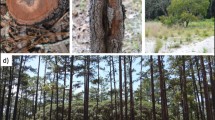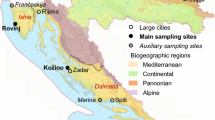Abstract
This study tests whether or not foliar flammability is related to resource-use and anti-herbivore defence strategies of plant species. We measured the flammability (at 400 °C) of 1640 dry and fresh leaves across 115 common native New Zealand woody and herbaceous species collected from sites throughout New Zealand. We used three indicators of foliar flammability—leaf temperature at smoke production and on ignition and the rate of increase in leaf temperature during the combustion process. We tested for relationships between these flammability measures, foliar morphological and chemical traits and growth form. All significant correlations showed increased foliar flammability with increasing foliar surface area:volume ratio (SAV) and nutrient content and decreasing tissue density, lignin and secondary metabolite concentrations. Coniferous trees were the growth form with the least flammable leaves due to leaf morphology associated low leaf SAV and high tissue density. This suggests there may be a general relationship between resource-use strategies and foliar flammability, via the influence of leaf morphology on both these aspects of plant function.





Similar content being viewed by others
References
Allan Herbarium (2000) Ngā Tipu o Aotearoa—New Zealand plant names database. Landcare Research, New Zealand. http://www.nzflora.landcareresearch.co.nz/. Accessed 31 Jan 2012
Augustine DJ, McNaughton SJ (1998) Ungulate effects on the functional species composition of plant communities: herbivore selectivity and plant tolerance. J Wildl Manage 62:1165–1183
Bee JN, Kunstler G, Coomes DA (2007) Resistance and resilience of New Zealand tree species to browsing. J Ecol 95:1014–1026
Blakemore LC, Searle PL, Daly BK (1987) Methods for chemical analysis of soils. New Zealand Soil bureau scientific report 80. New Zealand Soil Bureau, Lower Hutt
Blomberg SP, Garland T, Ives AR (2003) Testing for phylogenetic signal in comparative data: behavioural traits are more labile. Evolution 57:717–745
Bond WJ, Midgley JJ (1995) Kill thy neighbour—an individualistic argument for the evolution of flammability. Oikos 73:79–85
Bowman D, French B, Prior LD (2014) Have plants evolved to self-immolate? Front Plant Sci 5:590
Bradshaw SD, Dixon KW, Hopper SD, Lambers H, Turner SR (2011) Little evidence for fire-adapted plant traits in Mediterranean climate regions. Trends Plant Sci 16:69–76
Broadhurst RB, Jones WT (1978) Analysis of condensed tannins using acidified vanillin. J Sci Food Agr 29:788–794
Brooks ML, Matchett JR (2006) Spatial and temporal patterns of wildfires in the Mojave Desert, 1980–2004. J Arid Environ 67:148–164
Cambie RC (1996) A New Zealand phytochemical register. Part V. J Roy Soc of NZ 26:483–527
Cornelissen JHC, Perez-Harguindeguy N, Diaz S, Grime JP, Marzano B, Cabido M, Vendramini F, Cerabolini B (1999) Leaf structure and defence control litter decomposition rate across species and life forms in regional floras on two continents. New Phytol 143:191–200
DeFalco LA, Bryla DR, Smith-Longozo V, Nowak RS (2003) Are Mojave Desert annual species equal? Resource acquisition and allocation for the invasive grass Bromus madritensis subsp rubens (Poaceae) and two native species. Amer J Bot 90:1045–1053
Dimitrakopoulos AP, Papaioannou KK (2001) Flammability assessment of Mediterranean forest fuels. Fire Technol 37:143–152
Felsenstein J (1985) Phylogenies and the comparative method. Am Nat 125:1–15
Fogarty LG (2001) A flammability guide for some native New Zealand tree and shrub species. Forest research bulletin 143, forest and rural fire scientific and technical series report 6. Forest Research, Rotorua
Gould SJ, Vrba ES (1982) Exaptation-a missing term in the science of form. Paleobiology 8:4–15
Grafen A (1989) The phylogenetic regression. Philos T Roy Soc B 326:119–157
Grime JP (1977) Evidence for the existence of three primary strategies in plants and its relevance to ecological and evolutionary theory. Am Nat 111:1169–1194
Grime JP (2001) Plant strategies, vegetation processes, and ecosystem properties, 2nd edn. Wiley, Chichester
Keeley JE, Pausas JG, Rundel PW, Bond WJ, Bradstock RA (2011) Fire as an evolutionary pressure shaping plant traits. Trends Plant Sci 16:406–411
Kuijper DPJ, Jędrzejewska B, Brzeziecki B, Churski M, Jędrzejewski W, Żybura H (2010) Fluctuating ungulate density shapes tree recruitment in natural stands of the Białowieża Primeval Forest, Poland. J Veg Sci 21:1082–1098
Mason NWH, Peltzer DA, Richardson SJ, Bellingham PJ, Allen RB (2010) Stand development moderates effects of ungulate exclusion on foliar traits in the forests of New Zealand. J Ecol 98:1422–1433
Mason NWH, Richardson SJ, Peltzer DA, Wardle DA, De Bello F, Allen RB (2012) Changes in co-existence mechanisms along a long-term soil chronosequence revealed by functional trait diversity. J Ecol 100:678–689
McGlone MS, Basher LR (1995) The deforestation of the upper Awatere catchment, inland Kaikoura Range, Marlborough, South Island, New Zealand. NZ J Ecol 19:53–66
McGlone MS, Wilmshurst JM, Leach HM (2005) An ecological and historical review of bracken (Pteridium esculentum) in New Zealand, and its cultural significance. NZ J Ecol 29:165–184
McWethy DB, Whitlock C, Wilmshurst JM, McGlone MS, Li X (2009) Rapid deforestation of the South Island, New Zealand, by early Polynesian fires. Holocene 19:883–897
McWethy DB, Whitlock C, Wilmshurst JM, McGlone MS, Fromont M, Li X, Dieffenbacher-Krall A, Hobbs WO, Fritz SC, Cook ER (2010) Rapid landscape transformation in South Island, New Zealand, following initial Polynesian settlement. Proc Natl Acad Sci USA 107:21343–21348
Ogden J, Basher L, McGlone M (1998) Fire, forest regeneration and links with early human habitation: evidence from New Zealand. Ann Bot 81:687–696
Paradis E, Claude J, Strimmer K (2004) APE: analyses of phylogenetics and evolution in R language. Bioinformatics 20:289–290
Perry GLW, Wilmshurst JM, McGlone MS, McWethy DB, Whitlock C (2012) Explaining fire-driven landscape transformation during the initial burning period of New Zealand’s prehistory. Glob Change Biol 18:1609–1621
Perry GLW, Wilmshurst JM, McGlone MS (2014) Ecology and long-term history of fire in New Zealand. NZ J Ecol 38:157–176
Perry GLW, Wilmshurst JM, Ogden J, Enright NJ (2015) Exotic mammals and invasive plants alter fire-related thresholds in southern temperate forested landscapes. Ecosystems 18:1290–1305
Price ML, Butler LG (1977) Rapid visual estimation of and spectrophotometric determination of tannin content of sorghum grain. J Agric Food Chem 25:1268–1273
R Development Core Team (2009) R: a language and environment for statistical computing. R Foundation for Statistical Computing, Vienna. http://www.R-project.org. Accessed 1 Oct 2015
Rao LE, Allen EB, Meixner T (2010) Risk-based determination of critical nitrogen deposition loads for fire spread in southern California deserts. Ecol Appl 20:1320–1335
Reich PB, Walters MB, Ellsworth DS, Vose JM, Volin JC, Gresham C, Bowman WD (1998) Relationships of leaf dark respiration to leaf nitrogen, specific leaf area and leaf life-span: a test across biomes and functional groups. Oecologia 114:471–482
Rowland AP, Roberts JD (1994) Lignin and cellulose fractionation in decomposition studies using acid-detergent fibre methods. Commun Soil Sci Plan 25:269–277
Scarff FR, Westoby M (2006) Leaf litter flammability in some semi-arid Australian woodlands. Funct Ecol 20:745–752
Schwilk DW, Ackerly DD (2001) Flammability and serotiny as strategies: correlated evolution in pines. Oikos 94:326–336
Shipley B, Vu TT (2002) Dry matter content as a measure of dry matter concentration in plants and their parts. New Phytol 153:359–364
Stylinski CD, Allen EB (1999) Lack of native species recovery following severe exotic disturbance in southern Californian shrublands. J Appl Ecol 36:544–554
Wardle DA, Bonner KI, Barker GM (2002) Linkages between plant litter decomposition, litter quality, and vegetation responses to herbivores. Funct Ecol 16:585–595
Westoby M, Leishman MR, Lord JM (1995) On misinterpreting the ‘phylogenetic correction’. J Ecol 83:531–534
Wilmshurst JM, McGlone MS, Leathwick JR, Newnham RM (2007) A pre-deforestation pollen-climate calibration model for New Zealand and quantitative temperature reconstructions for the past 18,000 years BP. J Quat Sci 22:535–547
Wilson PJ, Thompson K, Hodgson JG (1999) Specific leaf area and leaf dry matter content as alternative predictors of plant strategies. New Phytol 143:155–162
Wiser SK, Allen RB, Platt KH (1997) Mountain beech forest succession after a fire at Mount Thomas Forest, Canterbury, New Zealand. NZ J Bot 35:505–515
Wright IJ, Reich PB, Westoby M, Ackerly DD, Baruch Z, Bongers F, Cavender-Bares J, Chapin T, Cornelissen JHC, Diemer M, Flexas J, Garnier E, Groom PK, Gulias J, Hikosaka K, Lamont BB, Lee T, Lee W, Lusk C, Midgley JJ, Navas ML, Niinemets U, Oleksyn J, Osada N, Poorter H, Poot P, Prior L, Pyankov VI, Roumet C, Thomas SC, Tjoelker MG, Veneklaas EJ, Villar R (2004) The worldwide leaf economics spectrum. Nature 428:821–827
Wright IJ, Ackerly DD, Bongers F, Harms KE, Ibarra-Manriquez G, Martinez-Ramos M, Mazer SJ, Muller-Landau HC, Paz H, Pitman NCA, Poorter L, Silman MR, Vriesendorp CF, Webb CO, Westoby M, Wright SJ (2007) Relationships among ecologically important dimensions of plant trait variation in seven Neotropical forests. Ann Bot 99:1003–1015
Wyse SV, Perry GLW, O’Connell DM, Holland PS, Wright MJ, Hosted CL, Whitelock SL, Geary IJ, Maurin KJL, Curran TJ (2016) A quantitative assessment of shoot flammability for 60 tree and shrub species supports rankings based on expert opinion. Int J Wildland Fire 25:466–477
Acknowledgments
This work was funded through the Ecosystem Resilience Outcome Based Investment administered by the New Zealand Foundation for Research, Science and Technology (Contract C09X0502), and by the New Zealand Department of Conservation. We thank Elaine Wright and Janet Wilmshurst for project support; Bill Lee for comments on an earlier draft; Grant Pearce, Stewart Anderson and Malcolm Gill for advice in developing methods for measuring flammability; and Keven Drew and Simon Burrows for technical assistance.
Author information
Authors and Affiliations
Corresponding author
Additional information
Communicated by Michael Lawes, Ross Bradstock, David Keith.
Nomenclature
Allan Herbarium (2000), accessed 31-1-2012
Electronic supplementary material
Below is the link to the electronic supplementary material.
Rights and permissions
About this article
Cite this article
Mason, N.W.H., Frazao, C., Buxton, R.P. et al. Fire form and function: evidence for exaptive flammability in the New Zealand flora. Plant Ecol 217, 645–659 (2016). https://doi.org/10.1007/s11258-016-0618-5
Received:
Accepted:
Published:
Issue Date:
DOI: https://doi.org/10.1007/s11258-016-0618-5




